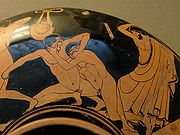
Foundry Painter
Encyclopedia




Ancient Greece
Ancient Greece is a civilization belonging to a period of Greek history that lasted from the Archaic period of the 8th to 6th centuries BC to the end of antiquity. Immediately following this period was the beginning of the Early Middle Ages and the Byzantine era. Included in Ancient Greece is the...
Attic
Attica
Attica is a historical region of Greece, containing Athens, the current capital of Greece. The historical region is centered on the Attic peninsula, which projects into the Aegean Sea...
red-figure
Red-figure pottery
Red-figure vase painting is one of the most important styles of figural Greek vase painting. It developed in Athens around 530 BC and remained in use until the late 3rd century BC. It replaced the previously dominant style of Black-figure vase painting within a few decades...
vase painter of the Late Archaic period. His real name is unknown; the conventional name is derived from his most famous work, the Berlin Foundry Cup
Berlin Foundry Cup
The Berlin Foundry Cup is a red-figure kylix from the early 5th century BC. It is the name vase of the Attic vase painter known conventionally as the Foundry Painter. Its most striking feature is the exterior depiction of activities in an Athenian bronze workshop or foundry...
.
Together with a number of other notable vase painters, such as the Briseis Painter or the Dokimasia Painter, the Foundry Painter was active in the workshop of one of the most important Late Archaic red-figure vase painters, the Brygos Painter
Brygos Painter
The Brygos Painter was an ancient Greek Attic red-figure vase painter of the Late Archaic period. Together with Onesimos , Douris and Makron, he is among the most important bowl painters of his time. He was active in the first third of the fifth century BCE, especially in the 480s and 470s...
. He was less productive than his master, but artistically nearly as talented. His style and subject range are very similar to those of the Brygos Painter, who seems to have had a strong influence on all his collaborators in those regards. Nonetheless, the Foundry Painter's style differs in certain details; John Beazley
John Beazley
Sir John Davidson Beazley was an English classical scholar.Born in Glasgow, Scotland, Beazley attended Balliol College, Oxford, where he was a close friend of the poet James Elroy Flecker. After graduating in 1907, Beazley was a student and tutor in Classics at Christ Church, and in 1925 he...
judged his works as powerful, sometimes even crude.
In contrast to his contemporaries, his figures seem heavier, their faces more schematic. His figures are well-observed, and sometimes depicted not without humour. Such figures as foolish lovers, rotund hetaira
Hetaira
Hetaira is a genus of bush cricket in family Tettigoniidae subfamily Phaneropterinae....
i and confounded revellers occur. He also attempted to depict body hair and to stress musculature. Additionally, he was one of the very few Late Archaic vase painters to experiment with shading.
Especially his symposium
Symposium
In ancient Greece, the symposium was a drinking party. Literary works that describe or take place at a symposium include two Socratic dialogues, Plato's Symposium and Xenophon's Symposium, as well as a number of Greek poems such as the elegies of Theognis of Megara...
scenes are closely connected with those of the Brygos Painter, although he adds his own characteristic perspective especially in details. Many of his mythical scenes can be described as original. Nonetheless, he is especially important because of his depictions of every-day life and of craft activity. For example, there is a vase by him that depicts a sculptor at work, watched by the goddess Athena
Athena
In Greek mythology, Athena, Athenê, or Athene , also referred to as Pallas Athena/Athene , is the goddess of wisdom, courage, inspiration, civilization, warfare, strength, strategy, the arts, crafts, justice, and skill. Minerva, Athena's Roman incarnation, embodies similar attributes. Athena is...
.
His most famous work is his name vase
Name vase
In classical archaeology, a name vase is a specific "vase" whose painter's name is unknown but whose workshop style has been identified. The painter is conventionally named after the selected "name vase" that embodies his characteristic style, or for one of its distinctive painted subjects, or for...
, kylix
Kylix (drinking cup)
A kylix is a type of wine-drinking glass with a broad relatively shallow body raised on a stem from a foot and usually with two horizontal handles disposed symmetrically...
in the Antikensammlung
Antikensammlung Berlin
The Antikensammlung Berlin is one of the most important collections of classical art in the world, now held in the Altes Museum and Pergamon Museum in Berlin, Germany. It contains thousands of ancient archaeological artefacts from the ancient Greek, Roman, Etruscan and Cypriot civilizations...
at Berlin
Berlin
Berlin is the capital city of Germany and is one of the 16 states of Germany. With a population of 3.45 million people, Berlin is Germany's largest city. It is the second most populous city proper and the seventh most populous urban area in the European Union...
, the so-called Berlin Foundry Cup
Berlin Foundry Cup
The Berlin Foundry Cup is a red-figure kylix from the early 5th century BC. It is the name vase of the Attic vase painter known conventionally as the Foundry Painter. Its most striking feature is the exterior depiction of activities in an Athenian bronze workshop or foundry...
. Its exterior depicts a bronze workshop; it is among the very few sources on ancient metal production. The Foundry Painter was active in the first third of the 5th century BC. He mainly painted drinking cups. Some of his works are in the white-ground technique
White Ground Technique
White-ground technique is a style of ancient Greek vase painting in which figures appear on a white background. It developed in the region of Attica.-Technique and style:...
.

